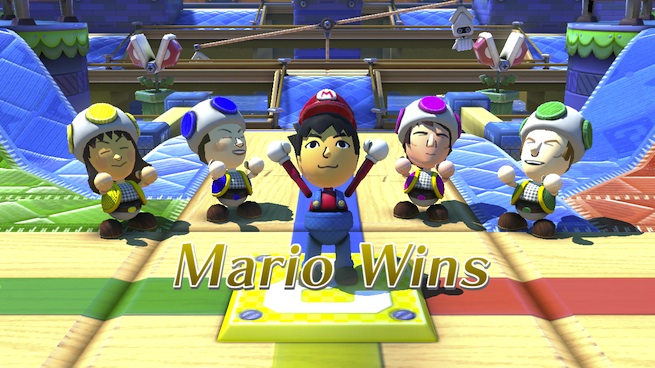The timer was ticking down to the last 30 seconds. My teammates and I ran, frantically trying to capture Mario — or at least an avatar dressed like him — in a color-coded landscape filled with hills and mud. “Back of yellow heading toward red!” one of them shouted. “No, he’s going in blue!” Suddenly, I saw him fly down a long slide. I ran as fast as I could to meet him at the bottom and made a desperate attempt at a midair tackle in the hope of catching him.
He soared over me as the clock reached zero, laughing at his stroke of luck. Even though I only met Corey, the Nintendo representative playing as Mario, just minutes before, I already hated him.
That’s the sort of competitive reaction Nintendo Land, a collection of minigames disguised as a virtual theme park, brings out of you. Available as a pack-in bonus for the Wii U Deluxe Set or separately on store shelves when the console launches on Nov. 18, Nintendo Land features 12 “attractions” inspired by many of its famous franchises, like Mario Chase (pictured above). And based on my experiences, they can get a little rowdy.
A fighting spirit
Nintendo Land’s multiplayer offerings, even in cooperative modes, all have some kind of competitive component. I first realized this while playing Pikmin Adventure, a fast-paced version of Nintendo’s popular alien-management strategy game. One player uses the GamePad and its stylus to control Captain Olimar, who commands a small army of Pikmin creatures. Any extra players (up to four) use Wii Remotes to play as larger Pikmin with different abilities.
Here’s the catch: Olimar can summon all of the Pikmin to his location with a special whistle during the mission-based Challenge mode. If you wanted to, you could abuse this mechanic by rounding them up as many times as you possibly can. Those with the Wii Remote can shake the controller to defy your orders and jump away, but chances are they’ll still find it annoying. You’ll also fight over Nectar pieces dropped by monsters (mechanical versions of the Bulborbs seen in earlier Pikmin games) or found in boxes. These help you level up, increasing the damage and number of Pikmin for Olimar or adding attack combos to the large Pikmins’ arsenal.
Once your relationship reaches a boiling point, you can head on over to the competitive multiplayer mode. It pits Captain Olimar against the Pikmin players in a small arena filled with power-ups (like hammers and bombs), and the goal is to collect as much candy as possible. You’ll lose the candy if you get hit even once, so it’s a constant struggle. Both modes contain a variety of stages to unlock, giving you many places to vent your frustration.
Metroid Blast, a minigame based on Nintendo’s Metroid series, is just as thrilling in 1-on-1 combat. The player with the GamePad controls a spaceship while the Wii Remote characters stay on the ground. One side doesn’t necessarily have an advantage over the other. Those on the ground can morph into a ball, swing across a level, and fire shots from their arm cannons. The ship comes with a slight learning curve to the controls, but it can reach places that the other players can’t. It also has a punishing volley of rockets to unleash on unsuspecting foes. Expect a good heap of trash talk to accompany the explosions and laser beams.
GamePad versus Wii Remotes
The reason this particular form of multiplayer works is because of Nintendo Land’s asymmetrical gameplay, which is when the minigame offers different experiences depending on what controller you use. In Mario Chase, the GamePad player is Mario, and he has to focus on the touch-screen’s top-down view of the map, along with a zoomed-in section, to find hiding spots or alternative paths to run through. When I was playing with three Nintendo reps, the GamePad’s camera was also on, projecting my lovely mug on the TV for everyone to see. You can use this to taunt your pursuers with any facial expressions that you see fit.
GamePad players have to hide the precious data it holds; usually, the Wii Remote crowd will have an entirely different view on the TV. Either side can cheat by taking a peek at the other’s screen, but where’s the fun in that? This is vital in games like Luigi’s Ghost Mansion. The GamePad controls a ghost, whose movements are invisible to the players hunting it down with their flashlights. You can reveal your presence either through recklessness (if you use the dash button), by the flashes of lightning outside the level (unless you’re hiding behind something), or on purpose (if you charge up a special attack). And the only way to conquer your intruders is to bait them into a series of traps by taunting them with your appearance.
As I quickly learned, it’s easy to get swept up in the GamePad’s novelty and its exclusive gameplay perspectives: It took only a minute before the ghost hunters defeated me. So it’s best not to rely on the GamePad as a crutch as determined players — or really experienced Nintendo employees — will find a way to knock you down.
[vb_gallery id=564825]
VentureBeat's mission is to be a digital town square for technical decision-makers to gain knowledge about transformative enterprise technology and transact. Learn More


